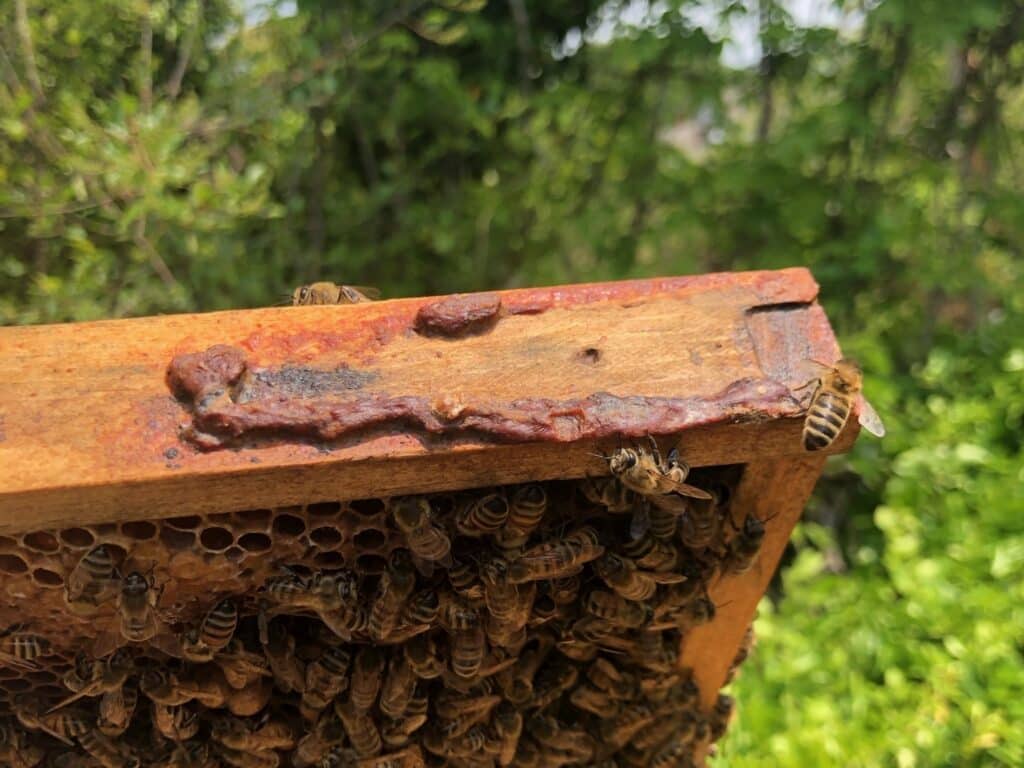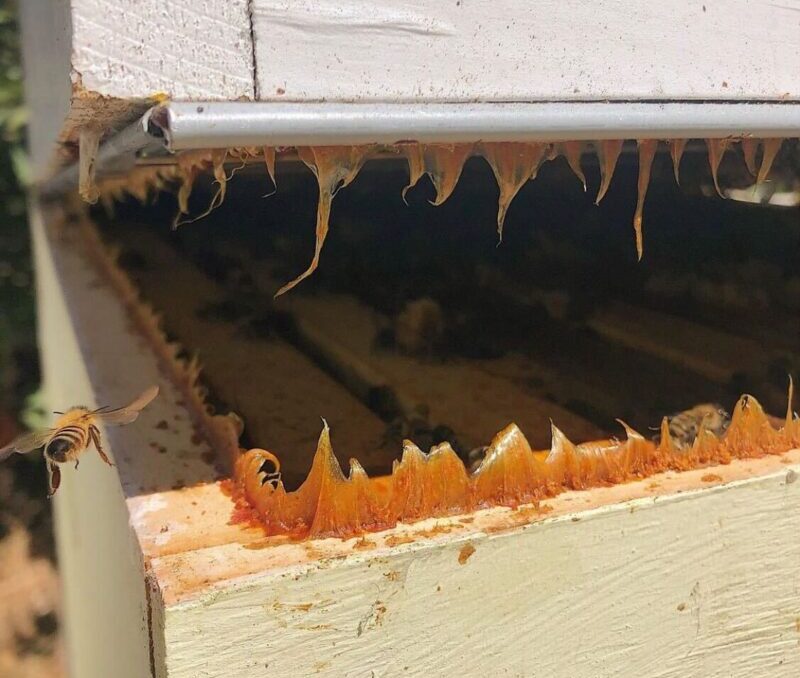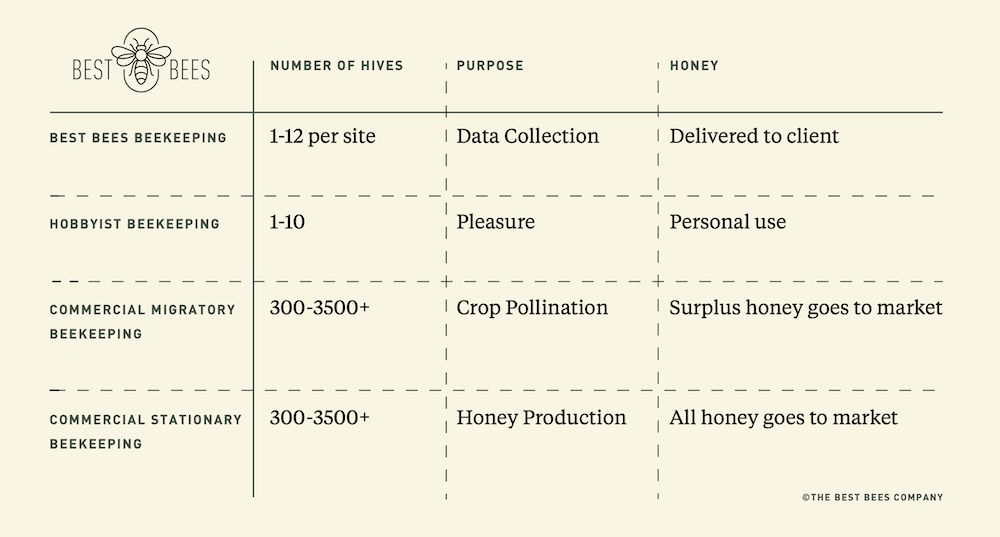Contents:
- What Is Propolis?
- How Do Bees Make Propolis?
- What Do Bees Use Propolis For?
- What Are the Properties of Propolis?
- History of Humans Using Propolis
- Propolis Use and Benefits for Humans
- Scientific Research Conducted About Propolis
- Sourcing Ethical Propolis
- FAQS
On our blog, we’ve talked about many beehive products – beeswax, honey, bee bread, and royal jelly. Now we’re highlighting propolis, the sticky, waxy substance formed by the combination of tree sap and beeswax that bees use to build and maintain their hive.
What Is Propolis?
The word “propolis” has its origins in the Greek language. Pro- means for, or in front of, and -polis means the city; it’s aptly named, as propolis is used to protect the “city” of bees. Resins from plants and trees are mixed with beeswax to create propolis: a malleable, waxy substance that is used to smooth rough surfaces and seal any holes or gaps in the hive. This allows the colony to control airflow and maintain homeostasis.
Propolis has been found to have antimicrobial properties; it plays an important role in the hive’s ability to fight off infection and diseases. In making propolis, the bees are essentially utilizing the immune system of trees for their own collective health. When a colony is sick, the bees collect extra propolis to bolster the hive. In this way, propolis use by honey bees can be considered an example of social immunity: a collective behavior that benefits the health of the colony as a whole.
How Do Bees Make Propolis?
Aside from pollen, nectar, and water, honey bees also collect resins from the cracks in the bark of trees and leaf buds. Once the pollen baskets on the bee’s hind leg gets full, she will fly back to the hive where propolis removal is carried out by mainly older bees, whose wax glands have been almost atrophied, while younger bees are busy building combs and capping cells for honey. This resin is masticated, which adds the bees’ unique salivary enzymes to the substance. The partially digested material is then mixed with beeswax to produce the final product of propolis.
What Do Bees Use Propolis For?
Honey bees use propolis in the construction and repair of their hives – it’s used for sealing openings and cracks, smoothing out and waterproofing the internal walls, and strengthening the protective barrier against external invaders or weather. Bees may use propolis as a natural kind of entrance reducer, minimizing the hive entrance size to make it harder for invaders to get inside.
Aside from simply acting as a kind of “glue” or cement for the hive, propolis plays an extremely important role in maintaining hive health. Propolis serves as a disinfectant of all surfaces in the hive. The bees will embalm killed invaders with propolis to prevent decomposition from causing infections. It is used as a natural antibiotic against microbial pathogens; propolis can have a direct effect on several hive pathogens, including American foulbrood, chalkbrood, and Nosema ceranae.
Studies have found that honey bees actually apply extra propolis to brood cells when a varroa mite infestation is present, with a positive effect on the bees and their resiliency to varroa mites. In this sense, propolis can be regarded as a natural pesticide used by honey bees to limit a dangerous parasite.
What Are The Properties of Propolis?
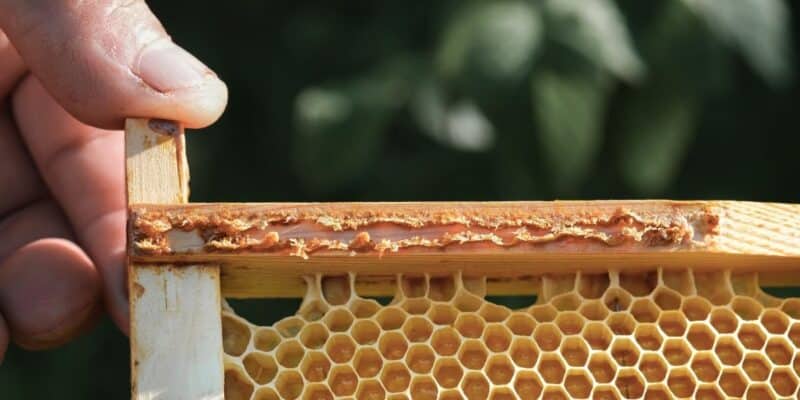
The Properties of Propolis at a Glance:
- Antimicrobial
- Antiseptic
- Anti-inflammatory
- Antioxidant
- Immunomodulatory
- Anticancer
- Antiprotozoan
- Neuroprotective activity
As with other beehive products, the composition of propolis varies from season to season and beehive to beehive – it depends on the resin foraged by the bees. However, this study revealed that bees in different regions harvest similar compounds from different plant families, so there is a baseline composition which allows for a generalized summary of the different properties of propolis. This is what makes propolis immunomodulatory – while the exact composition may vary, it is always specifically made to support the immune system.
The most studied and well-documented property of propolis is its antimicrobial activity. Antimicrobials kill or slow the spread of microorganisms, particularly pathogenic ones; this includes bacteria, viruses, protozoans, and fungi. This property means that propolis is also antiseptic, antibacterial, antiviral, and antifungal. Several studies have also associated different types of propolis and its various constituents with anti-inflammatory activity.
These properties have been largely investigated in recent years due to the need for new treatments against infectious diseases, especially with the increase of resistant pathogens to current antibiotics. Honey has very similar properties that have been studied for the same reason.
A study published in the Biochemical and BioPhysical Research Communications journal revealed promising results for understanding propolis’ potential for treating gastrointestinal illnesses. This is because of its immunomodulatory functions – the main immunopotent chemicals in propolis have been identified as caffeic acid phenethyl ester (CAPE), the flavonoid chrysin, and artepillin C.
The flavonoids concentrated in propolis, including chrysin, are powerful antioxidants. Artepillin C has a wide range of pharmacological benefits, including antioxidant, anti-inflammatory, anti-diabetic, neuroprotective, gastroprotective, and anti-cancer effects.
Multiple studies have investigated the antitumor and anticancer properties of propolis, and found that its presented compounds (specifically, CAPE and chrysin) may inhibit tumor cell progression, suppress cancer cell proliferation via its anti-inflammatory effects, decrease cancer stem cell population, and exert antiangiogenic effects – preventing or slowing the growth of cancer by reducing the growth of new blood vessels, thus starving it of its needed blood supply.
The History of Humans Using Propolis
Since ancient times, at least to 300 BC, propolis has been extensively used by mankind, especially in folk medicine. The ancient Egyptians, one of the primary beekeeping ancient civilizations, learned from the bees and used propolis in their embalming process. The ancient Jews considered tzori (the Hebrew word for propolis) as a medicine. Tzori and its therapeutic properties are mentioned throughout the Old Testament; the biblical Balm of Gilead is nearly indistinguishable from propolis. The Incas employed it as an antipyretic agent. Greek and Roman physicians used propolis as a mouth disinfectant and as an antiseptic and healing product in wound treatment, prescribed for topical therapy of cuts, wounds, and burns.
Propolis was listed as an official drug in the London pharmacopeias of the 17th century. Due to its antibacterial activity, propolis became popular in Europe between the 17th and 20th centuries, and was used to treat wounds during World War II.
Propolis Use and Benefits For Humans
Uses of Propolis at a Glance:
- Help the body resist infections
- Relieve dermatitis and neurodermatitis
- Wound healing
- Burn treatment
- Acne, eczema, and psoriasis treatment
- Cavity prevention
- Gingivitis and stomatitis treatment
- Alleviate cold and flu symptoms
Modern herbalists, like Best Bees beekeepers Mariah McDonald and Emily Lawes, recommend propolis for its antibacterial, antifungal, antiviral, hepatoprotective, and anti-inflammatory properties, to increase the body’s natural resistance to infections. Mariah, our San Francisco Regional Manager and Level 2 Beekeeper, is a long-practicing herbalist and a strong proponent of the benefits of propolis.
“It helps the immune system because it increases antioxidant enzymes, preventing oxidative stress … propolis actually goes in and addresses stress at a molecular level. It helps alleviate the human biome of cellular stress to create a more functioning, capable body that will be able to keep itself healthy,” Mariah said.
Propolis is popularly used in formulations for cold syndrome (upper respiratory tract infections, common cold, and flu-like infections), such as cough syrup, lozenges, throat sprays, and tinctures. Additionally, it is used in mouthwashes and toothpaste to prevent cavities and to treat gingivitis and stomatitis. It has been recommended in gargle or spray form as a remedy for sores and irritations in the mouth, and in tincture form to treat canker sores and sore throats.
Emily Lawes, our DC Regional Manager and Level 3 Beekeeper, is studying herbalism and used a homemade propolis tincture to treat a toothache she had.
“I applied a drop of my propolis tincture and rubbed it into my gum two to three times a day for three days in a row. At that point, the problem had totally resolved itself,” Emily said.
Emily pointed out that propolis, when ingested, supports the interior workings of the human body much in the same way that it supports the healthy functioning of the hive.
Propolis is also useful in dermatological preparations for wound healing, treatment of burns, herpes, and various types of dermatitis and neurodermatitis. It is widely used as a component in pharmaceutical and cosmetic products such as anti acne creams, facial and body creams, and ointments and lotions. Due to its wound-healing capabilities, propolis products have been reported to be beneficial for treating the aftermath of acne, such as scarring, pigmentation, and textural issues. It is also beneficial in the treatment of eczema and psoriasis because of its anti-inflammatory properties.
As with any beehive product, people need to conduct patch-tests prior to using or ingesting propolis products to assess whether or not they are allergic or have any sensitivities to this natural product. If applying a propolis product to the skin, there’s a risk of developing an allergic reaction or contact dermatitis. Both Mariah and Emily stress the importance of testing your body’s reaction to any kind of substance prior to using, because each individual’s body may react differently to different substances.
Scientific Research Conducted About Propolis
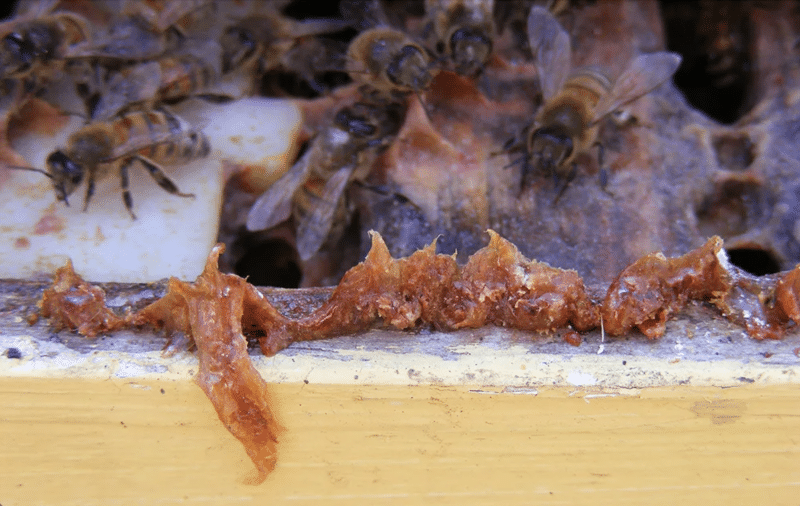
The first scientific work with propolis was published in 1908, and included its chemical properties and composition. Due to it possessing a broad spectrum of biological activities, it has gained significant scientific and commercial interest over the last two decades.
In their article “Lessons from Exploring Chemical Space and Chemical Diversity of Propolis Components”, published in 2020 in the International Journal of Molecular Sciences, authors Trong et al searched for the number of scientific publications and patents containing the word “propolis” per decade going back to 1900:
- In the years between 1991 and 2000, they found 919 publications and 412 patents.
- For 2001 through 2010, they found 3.5k publications and 1.4k patents.
- For the years between 2011 and 2019 (the year prior to the publication of the article), the team found 8,812 publications and 4,455 patents.
Unlike many ‘natural’ remedies, there is a substantive database on the biological activity and chemical composition of propolis indicating that it may have many antibiotic, antifungal, antiviral and antimicrobial properties, among others.
One 2019 review notes that propolis may stimulate collagen production in the skin, which, in addition to its anti-inflammatory and antimicrobial properties, supports wound and burn healing. The same review also reported that propolis may possess neuroprotective effects against multiple sclerosis (MS), Parkinson’s disease, and dementia.
A different study found that when topical propolis was applied three times a day, it helped heal cold sores faster than no treatment. The researchers found the propolis cream not only reduced the amount of herpes virus present in a person’s body, but also protected the body against future cold sore breakouts.
A 2021 review found that, due to propolis’ antibacterial and anti-inflammatory properties, it can help treat mouth and throat infections, as well as cavities.
Another 2021 study investigated propolis’ potential for treating certain cancers as well. The study found that propolis may keep cancerous cells from multiplying, reduce the likelihood cells will become cancerous, block pathways that keep cancer cells from signaling each other, and reduce side effects of certain cancer treatments, such as chemotherapy and radiation therapy.
A 2022 review suggests that propolis may have implications in the prevention and treatment of type 2 diabetes; it’s thought that its flavonoids may help control insulin release. A different study from 2017 reported that ingesting a propolis supplement improved glycemic control in patients with type 2 diabetes. Still another study, this one from 2015, noted that propolis exerts antioxidant, anti-inflammatory and analgesic effects that may improve diabetic complications.
Several studies have pointed to propolis being beneficial when used to treat cognitive impairment, neurodegeneration, and neurological disorders because of its anti-inflammatory, antioxidant, and immunomodulatory properties.
Sourcing Ethical Propolis
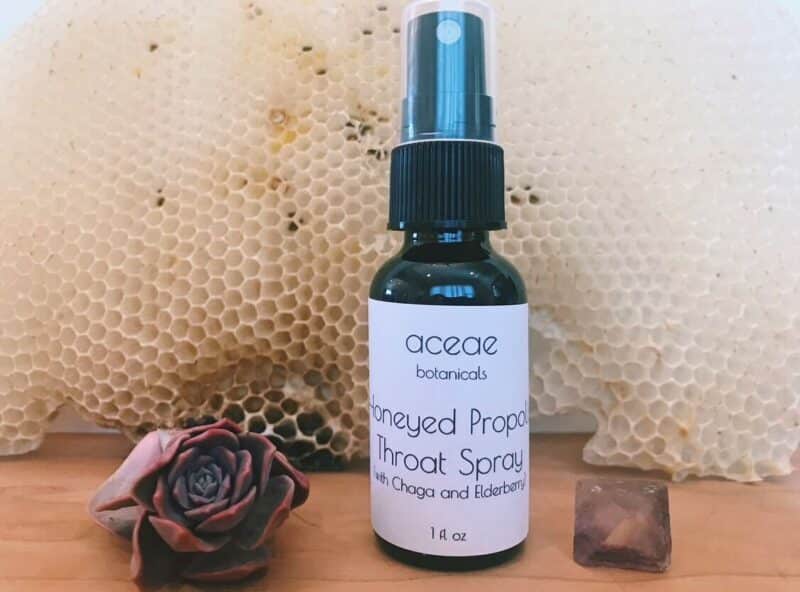
Propolis serves as an extension of the honey bee colony superorganism’s immune system, as well as an important construction material. Because of this, collecting it can have negative effects on the colony if not sustainably sourced; the commercial collection of large quantities of propolis is not a sustainable practice. It’s important to source propolis and propolis products from local beekeepers and small businesses that prioritize the health of the bees.
Emily Lawes makes and sells propolis tinctures at her local farmer’s market in Baltimore, Maryland using propolis from her personal beehives. She says that she harvests the propolis the bees put between frames, as it can build up and make pulling frames out harder (propolis is also called “bee glue”).
“I’ll scrape [the propolis] away and either throw it back into the hive or set it aside for tincture. I’ll also scrape the sides of the frames when I harvest honey, so then they’ll slide back in nicely when I’m done,” Emily said.
Mariah McDonald also makes her own propolis products using her personal beehives. Mariah pointed out that similarly to honey, she doesn’t harvest propolis from hives that aren’t producing an excessive amount. Additionally, she stops harvesting propolis in the fall to ensure the hive has ample propolis to make it through the winter, as propolis is an important waterproofing and insulating agent.
“Propolis isn’t as abundant as honey, and we don’t always harvest honey either. A big part of ethical beekeeping and sustainable practices is always assessing each hive’s situation at an individual level, and making sure that you’re only harvesting from hives that are producing in abundance,” Mariah said.
FAQs
Q: What is propolis?
A: Propolis is a malleable, waxy substance made from the resins from plants and trees mixed with beeswax.
Q: What is special about propolis?
A: Propolis has a multitude of beneficial properties; it is antimicrobial, antifungal, antiseptic, immunomodulatory, among many others.
Q: What is propolis used for in the hive?
A: Bees use propolis as a kind of “glue” for sealing cracks, waterproofing interior walls, and reducing the size of the hive entrance. It also serves the vital role of helping the colony fight off infection and disease; it is used as a natural antibiotic against microbial pathogens.
Q: Are honey bees the only bees to make propolis?
A: No, honey bees are not the only ones to make and use propolis! Many species of solitary bees use resins to line the small cavities where they lay their eggs, because it disinfects the surface and creates a safe environment for the developing larvae.
Q: Can humans use propolis?
A: Yes, humans have been using propolis for thousands of years! It has many beneficial properties that lend themselves to a plethora of uses.
Q: Is propolis safe for humans?
A: Propolis is nontoxic but, as with any beehive product, can trigger bee-related sensitivities or allergic reactions. Additionally, if being used topically, there is a risk, as with any regularly topically applied ingredient, of contact dermatitis. People should patch-test propolis and propolis products on their inner forearm a week prior to starting any propolis treatment.


